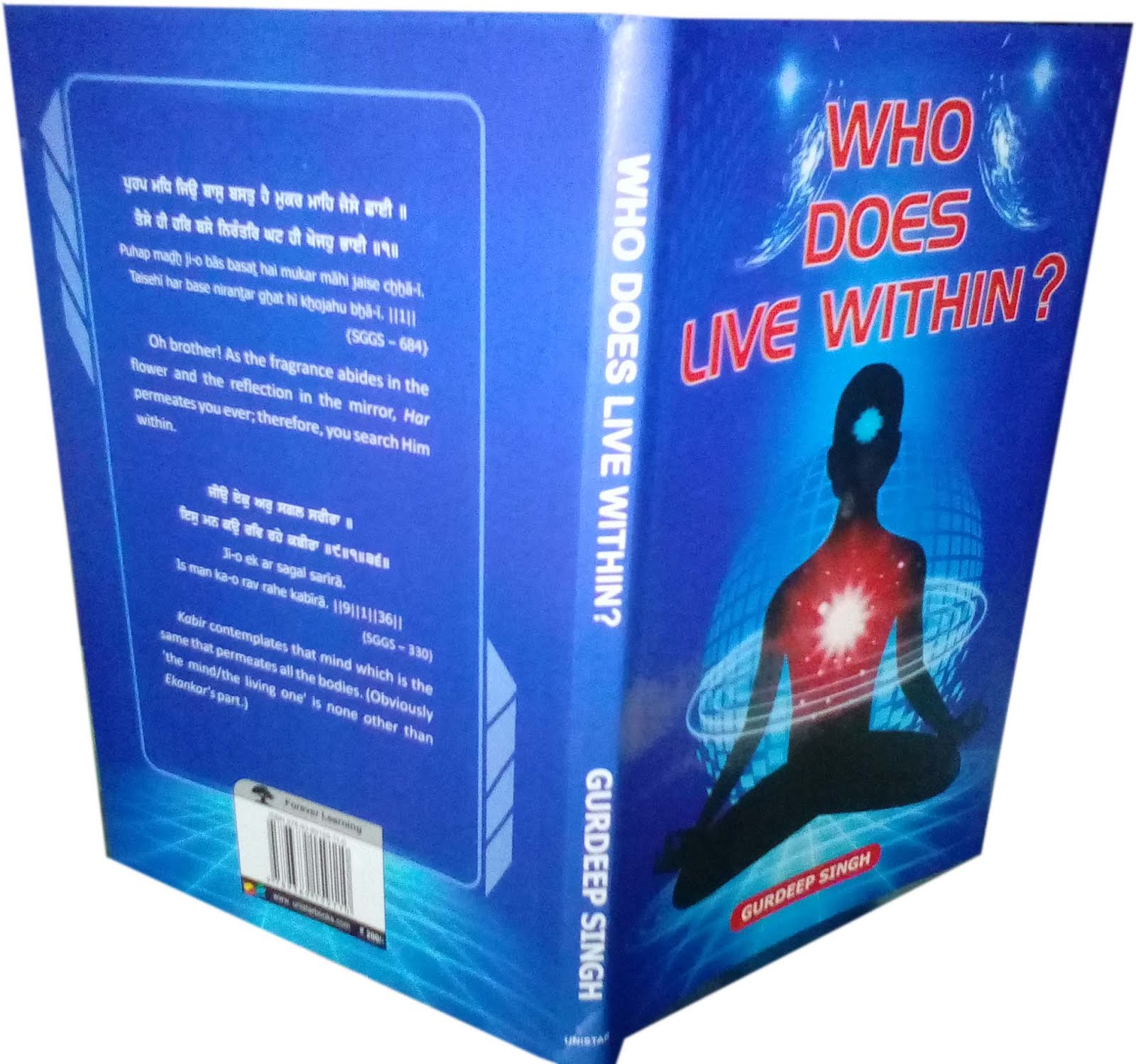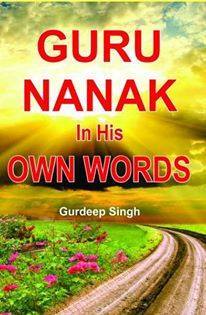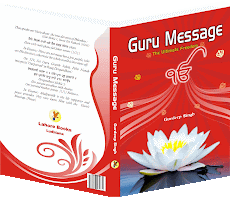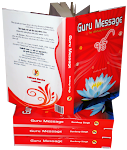If
we don’t understand Mool Mantra (A prelude To Jap Ji), we know nothing about
Sikhi; without understanding the concept of the Creator in “Mool Mantra”, we
simply build our pyramids of knowledge based on stories told over times by
those, who were more interested in the pursuit of their own quest than understanding
fully the goal of the Gurus, or we, even being Sikhs, are indulging in implying
ideas of our own limits to every word used in Mool Mantra; if so, we often
forget that every word used in Mool Mantra is elaborated in Sri Guru Granth in
detail with examples (Please check on 33,54,73,78,99,108, 302,391,720, 759,
916, 930, 931, 1291 and1385,SGGS ). First Nanak introduces to us the Creator he
has adored, praised and realized; his goal is to take the followers away from
prevailed misconceptions about the Creator (Ekkankaar) and to lead them
directly to Ekkankaar, who, even being above forms and visibility, permeates
all. Through Many shabdas, it is made clear that Enkkaar is “One All Pervading
Creator; in other words, He is present very much within all (Please check for
references on 11, 25, 33, 47, 56,128, 152 and 181 SGGS).
It
is a commonplace practice to define “ੴ / Ikk Onakaar” as a new and a complete
description of “OM” in some Sikh circles, but It is not true if we look at its
description in Sri Guru Granth Sahib. We see that First Nanak elaborates “ੴ” further
through the words that follow this abbreviation. From where he has taken the
word “ਓ” is very clear from its own form; it is not found “as it is” in any
ancient scriptures of India. While reading the Upanishad and the Simirtis, we
come across a word “Aum” used for “Atam”.
In the Mandukya Upanishad (1-12), it is stated, “ Aum, is an eternal
word. It symbolizes what was, what is, and what shall be. It also represents
what is beyond the present and beyond the future”. Interestingly, this concept
keeps changing in those scriptures though, please read on: “God is all and the
soul is God. The soul has four conditions. First condition is wakefulness, when
the senses are turned outwards focusing on external world. The second condition
is dreaming, when the senses are turned inwards focusing on past deeds and
present desires. The third condition is dreamless sleep when desires are
resting. The fourth condition is purity. The senses are neither turned outwards
nor inwards; there neither wakefulness nor dreaming. This condition is supreme
consciousness; when there is complete awareness of the Soul. This fourth condition
is expressed by the syllable Aum.” This
Upanishada calls the soul, God, but it also expresses "Aum” not as God but
a Syllable that represents fourth condition of the soul. After reading all that
sometimes, the words like “Aum”, “Soul or Supreme Soul” and “God” appear to
convey the meaning of the Creator, but sometimes, they appear to give different
meanings; for example: God is all and the soul is God” as stated above, but
look at this another example, “ by means of the soul, all living beings can
know God; and this knowledge fills them with joy … “ Taittiriya Upanishad 2-6,
7. If through a soul, God is known; obviously, it appears that God is separate
from the soul; by reading this, the mind certainly get confused about the
concept of God and the soul expressed in there. In the Rig Veda, Aum is
expressed as divine syllable, the sustainer of the world:
“The
four quarters of the sky, reach down to the oceans on the edge of the universe,
and from there, the waters flow, the whole universe is sustained by the divine
syllable, Aum, which flows
everywhere” Rig Veda 1:164-4,
45-46,51-52
Later
on in the Rig Veda, it is stated that God is one with many names, but wise men
know that He is one. No wonder, the Guru
refers to such thought of the Veda in the Gurbani by saying that what the
reality is expressed in the Vedas, however, the believers of the Vedas don’t
believe; instead they follow later on sages, who led them to idol worshiping (Please
check on 919 SGGS and 556 SGGS). Let us
see how the Guru expresses the Creator:
The
Guru differs slightly with the Upanishad and the Vedas; the soul is not
Ekkankaar, but a part of iEkkankaar, because Ekkankaar is also separate from
the soul though the Creator exists in the lives like the butter in the milk. Now look on 966, Mehla 5:
ਆਪੇ
ਸਭਨਾ ਮੰਝਿ ਆਪੇ ਬਾਹਰਾ ॥Āpe
sabẖnā manjẖ āpe bāhrā.
In
Essence: Prabh is within all, and Prabh is beyond all.
There
is very interesting statement in “Isa Upanishad “
“God
travels and yet he does not, He is far away and yet He is near. He is in all
beings, yet He is outside all beings”
It
adds:
“Those,
who find God within themselves, and find God in others, lose all fear; those,
who are at one with all beings, and discern the unity of all beings, lose all
sorrows.
Isa
Upnishda 1-2,4-8
Above
is very closest statement to the Gurbani in context of the Ikkankaar. Interestingly, the soul is treated as one
entity pervading all in the Upanishad, but the Gurbani takes it further by
separating the Creator completely from His Creation (555, SGGS):
ਪਉੜੀ
॥ ਆਪੇ ਸਭ ਘਟ ਅੰਦਰੇ ਆਪੇ ਹੀ ਬਾਹਰਿ ॥ ਆਪੇ ਗੁਪਤੁ ਵਰਤਦਾ ਆਪੇ ਹੀ ਜਾਹਰਿ ॥ ਜੁਗ ਛਤੀਹ ਗੁਬਾਰੁ ਕਰਿ ਵਰਤਿਆ ਸੁੰਨਾਹਰਿ ॥ ਓਥੈ ਵੇਦ ਪੁਰਾਨ ਨ ਸਾਸਤਾ ਆਪੇ ਹਰਿ ਨਰਹਰਿ ॥ ਬੈਠਾ ਤਾੜੀ ਲਾਇ ਆਪਿ ਸਭ ਦੂ ਹੀ ਬਾਹਰਿ ॥ ਆਪਣੀ ਮਿਤਿ ਆਪਿ ਜਾਣਦਾ ਆਪੇ ਹੀ ਗਉਹਰੁ ॥੧੮॥
Pa▫oṛī. Āpe sabẖ gẖat anḏre āpe hī bāhar. Āpe gupaṯ varaṯḏā āpe hī jāhar. Jug cẖẖaṯīh gubār kar varṯi▫ā sunnāhar. Othai veḏ purān na sāsṯā āpe har
narhar. Baiṯẖā ṯāṛī lā▫e āp sabẖ ḏū hī
bāhar. Āpṇī miṯ āp jāṇḏā āpe hī
ga▫uhar. ||18||
Stanza.
In Essence: Prabh Himself is within all but also exists outside. Prabh prevails
hidden and also He has become manifest. For thirty six ages, Prabh had been
there by Himself in pitch darkness. During that time, there were no the Puranas
and the Shastras but Prabh by Himself. Prabh is sitting in a trance separate
from all. Prabh knows His limits though He is unfathomable ocean.
(Note:
Prabh has no gender, the pronouns like “He or Himself or him” are simply used
to understand Ekkankaar as all pervading force/ wave/ light as in the Gurbani,
Prabh is expressed with famine verbs like “rav riha, not rav rahee; it is just a way out to express Prabh)
In
context of Onakaar, let us read First Nanak on 929 SGGS:
ਓਅੰਕਾਰਿ
ਬ੍ਰਹਮਾ ਉਤਪਤਿ ॥ ਓਅੰਕਾਰੁ ਕੀਆ ਜਿਨਿ ਚਿਤਿ ॥ ਓਅੰਕਾਰਿ ਸੈਲ ਜੁਗ ਭਏ ॥ ਓਅੰਕਾਰਿ ਬੇਦ ਨਿਰਮਏ ॥ ਓਅੰਕਾਰਿ ਸਬਦਿ ਉਧਰੇ ॥ ਓਅੰਕਾਰਿ ਗੁਰਮੁਖਿ ਤਰੇ ॥ ਓਨਮ ਅਖਰ ਸੁਣਹੁ ਬੀਚਾਰੁ ॥ ਓਨਮ ਅਖਰੁ ਤ੍ਰਿਭਵਣ ਸਾਰੁ ॥੧॥
O▫ankār
barahmā uṯpaṯ. O▫ankār kī▫ā jin cẖiṯ. O▫ankār sail jug bẖa▫e. O▫ankār beḏ nirma▫e. O▫ankār sabaḏ uḏẖre. O▫ankār gurmukẖ ṯare. Onam akẖar suṇhu bīcẖār. Onam akẖar ṯaribẖavaṇ sār. ||1||
In
Essence: Brahama was from Onakaar. Brahama cherished Onakaar in his mind. The
entire world and the time difference of yuga (ages) have existed from Onakaar;
From Onakaar the Vedas came into existence. Through Onakaar, the shabda saves;
because of Onakaar, the Guru followers are saved; thus, Onakaar ferries across
the mortals through the Guru. Listen (oh Pundit!)! Ponder over the word “onam”
you write. This word “onam” is for Akalpurakh who is the essence (the origin)
of the whole world.
Note;
The Guru is addressing those people who write “onam nameh” for idols.
It
is this word “Onakaar” , which was literally corrected by First Nanak by
attaching number one (੧) with it. When both are put together, it is pronounced
as Ekkankaar as it is expressed in the Gurbani.
As
we study the Gurbani, it becomes very clear that there is no other entity but
one Creator that runs the entire show of the world and beyond. Obviously, using
number one with “Onakaar” (Onakaar is described in the Gurbani, we know that
(Please check on 885 and 999 SGGS Mehla 5, 929, 1285 SGGS, Mehla 1), the Guru
stresses on oneness of the Creator. It
is clear that the Guru doesn’t accept word “Om” and “Aum” as complete defining words of Onakaar’s virtues; therefore, he
takes “ਓ” to complete its meaningful usage, and its sound becomes different
from “Aum ” and that is “ ਓਅੰਕਾਰ “(929 SGGS); obviously, there is no sound of
“Om.” This very word is also used by Bhagat Kabir as well (on 340 SGGS); however,
the Guru brings it to its new version and that is “ੴ”. It is well explained in the
Gurbani as stated earlier. Stress here is given on Ekkankaar’s being one (ਸਦਾ ਸਦਾ ਇਕੁ ਏਕੰਕਾਰ, 276,SGGS ) with power of pervading all over. Bhai
Gurdas defines the Mool Mantra in a compact version:
“ਏਕਾ
ਏਕੰਕਾਰੁ ਲਿਖਿ ਦੇਖਾਲਿਆ ।
aykaa
aykankaaruz|ikhi daykhaaliaa|
By
writing 1 (One number) in the beginning, Ekkankar is defined as the one only (ਏਕੰਕਾਰੁ is the right pronunciation of ੴ; please on
153, SGGS Mehla 1)
ਊੜਾ
ਓਅੰਕਾਰੁ ਪਾਸਿ ਬਹਾਲਿਆ ।
oorhaa
aoankaaru paasi bahaaliaa|
(With
the first number), and by using “oorha” as “Onakaar” with it (number one),
ਸਤਿ
ਨਾਮੁ ਕਰਤਾਰੁ ਨਿਰਭਉ ਭਾਲਿਆ ।
sati
naamu karataaru nirabhau bhaaliaa|
(the
idea continues)the reality of Naam of fearless Creator is made understood,
ਨਿਰਵੈਰਹੁ
ਜੈਕਾਰੁ ਅਜੂਨਿ ਅਕਾਲਿਆ ।
niravairahu
jaikaaru ajooni akaaliaa|
and
also it is explained that the Creator is beyond enmity, birth and death.
(Vaaran Bhai Gurdas)
Bhai
Gurdas had the honor of scribing the Gurbani as per the order of Fifth Nanak;
obviously, he got the Mool Mantra understood completely by being very close to
Fifth Nanak. Some people question him too, why they do so, I wonder?
Now
let us see how far First Nanak goes to express “ੴ” in his own words.
ੴ ਸਤਿ
ਨਾਮੁ ਕਰਤਾ ਪੁਰਖੁ ਨਿਰਭਉ ਨਿਰਵੈਰੁ ਅਕਾਲ ਮੂਰਤਿ ਅਜੂਨੀ ਸੈਭੰ ਗੁਰ ਪ੍ਰਸਾਦਿ ॥
Ik▫oaʼnkār
saṯ nām karṯā purakẖ nirbẖa▫o nirvair akāl mūraṯ ajūnī saibẖaʼn gurparsāḏ.
ੴ: before First Nanak, there was “Onakaar,” as
we see, this word “Onakaar” was used by Bhagat Kabir, who was here before First
Nanak. it was indeed used for the Creator, but First Nanak used “੧” with
Onakaar; it consists of two parts, first is, “”On” and the second is “Kaar”; (Onakaar”
has been also used in the Gurbani as the
Creator of “the beginning”(1061 SGGS) “Kaar” is described by Bhai Veer Singh as
“only one special” (Sri Guru Granth
Sahib Kosh-51), but as per Dr Sahib Singh,
it means“ All Pervading equally”. First Nanak adds with it “੧” to convey
oneness of “Onakaar; in simple words, as per the Guru,” Akalpurakh (Onakaar) is
the only one, who pervades all over equally”. Here it also represents the
Creator and all the names given to Ekkankaar. The Gurus and the Bhagatas call
the Creator with numerous names; many of such names were attached to some exceptional
personalities of mythology or the History of India; that is why they (all the
Gurus and the Bhagatas) keep calling Ekkankaar as “all pervading” to separate
Prabh from all other established entities, who bore these (His) names (Please
see examples on 436, SGGS and 469, SGGS); however, they departed from here as
per the “Will” of Ekkankaar. Obviously they couldn’t be “Ekkankaar”
“ਸਤਿ”
conveys many kinds of meanings like “true, charity, good deeds, all pervading
reality and so on.” It depends in what context it is used; here it is used
with “Naam” obviously it is about Ekkankaar; we should realize that Ekkankaar
is addressed in the Gurbani as Naam or Naon also; therefore, its meaning
has more depth here, “Satt” originates from Sanskrit-word “Sattya” which means
that who/which has existence (Dr Sahib Singh) and this existence is, “all
pervading truth”. The Guru further calls Ekkankaar “an existing reality” by
using the word,” ਸਤਿ ਨਾਮੁ .” “Satnaam” literally means He truly exists;
some scholars interpret “Satnaam” as “His Name is true/eternal”; however, His
eternity is expressed by calling Ekkankaar as “a being Akal/beyond death” and
also it is also expressed in the Sloka that follows the “Mool Mantra”.
Therefore, I feel, its meaning is “Akalpurakh is an existing reality not a myth”.
“ਕਰਤਾ
ਪੁਰਖੁ”, it has two words, “ਕਰਤਾ” means creator. ਪੁਰਖੁ is used most
of the times for a man but it is also used for “supreme Soul.” In Bhagwat Gaeta,
it is used for “soul” (Dr SS); In Sri Guru Granth Sahib, it is used for
“all pervading soul/light” (SGGS 291). Now we should look how First Nanak does
stress on Akalpurakh's “being active as a Creator, who is All Pervading.”
After this, Ekkankaar’s known qualities follow; these qualities are not seen
often in human beings and some of these qualities are very important to adopted
to have Ekkankaar’s vision. This fact is repeatedly elaborated in the various
Shabadas in Sri Guru Granth Sahib where ever blending in Ekkankaar’s color is
stressed. Some people say that when Prabh is active as a creator, how He can be
formless? They feel that ਨਿਰੰਕਾਰ / NIRANKAAR doesn’t mean formless; to answer
them, it is enough to say that the wind is formless but it remains active in
some forms. Second, in Sri Guru Granth Sahib, it is repeatedly said: ਤਿਸੁ ਰੂਪੁ
ਨ ਰੇਖਿਆ ਘਟਿ ਘਟਿ ਦੇਖਿਆ ਗੁਰਮੁਖਿ ਅਲਖੁ ਲਖਾਵਣਿਆ
॥੧॥ ਰਹਾਉ ॥Ŧis rūp na rekẖ▫i▫ā gẖat gẖat ḏekẖi▫ā gurmukẖ alakẖ lakẖāvaṇi▫ā. ||1|| rahā▫o.
(Prabh) Who has no form or shape; is seen within each
and every heart. The Gurmukh comes to know the unknowable. ||1||Pause| (130)
In the same way, Ekkankaar is also expressed as all the creation, which
is all about Prabh’s presence in the creation, because it is a part of Ekkankaar.
I just wonder how someone even can say that Ekkankaar is not
formless!
“ਨਿਰਭਉ
ਨਿਰਵੈਰੁ “.ਨਿਰਭਉ means fearless; it means the Creator has no fear of anyone.
ਨਿਰਵੈਰੁ, means the one, who doesn’t hold any kind of grudge or animosity
against any one. As He is the Creator of all, why should He fear from
anyone? As He is an active creator of all ---good and evil--- why should
He keep grudge or animosity against anyone? The total creation is His own
through which He permeates; both words fear and animosity do not fit in His
nature of being a Creator. Anyone if ever says that the Creator is angry;
obviously, is an ignorant. It is the humans who think about revenge or settling
the scores. Ekkankaar’s devotees, being in love with Him, earn such qualities
through meditating on Him with His grace. Tenth Nanak taught his khalsa to
harbor these two qualities even in case of self defense, and his warrior
followers earned these qualities and kept them intact while fighting an
aggression. When they lost these qualities, they fell down from His grace. When
one chooses to side with the fearless Creator, who is without animosity, one
must become like the Creator in one’s behavior. In the next words, the Guru
describes Ekkankaar’s eternity.
“ਅਕਾਲ
ਮੂਰਤਿ “, ਅਕਾਲ means beyond times, ਮੂਰਤਿ means “form”; it means His form is
beyond times. It is stressed that never ever the Creator dies as the
mortals do, and the time has no effect on the Creator; why? Its answer is
expressed in the next word, ““ਅਜੂਨੀ ਸੈਭੰ”.
“ਅਜੂਨੀ
ਸੈਭੰ”: ਅਜੂਨੀ, means beyond birth. One, who takes birth, has to die; it is a law of the nature: taking body, which is perishable in its nature, is
limiting the time span of existence; it is also Prabh’s Ordinance. Akalpurakh
is beyond times, because He doesn’t take birth. If that is the case, how did Ekkankaar’
come into existence? First Nanak answers this question through the word, “ਸੈਭੰ”
which means “He exists from His own- self or light/wave”. Obviously, there is
nothing from which Ekkankaar’ came into existence as we do from a father and
mother. This word dispels all illusions created about Prabh’s existence.
Wherever in metaphoric expressions, Ekkankaar’s manifestation is discussed, it
must not be interpreted in a literal meaning; those, who do so, certainly will
envelop in duality, which is not accepted by the Guru.
As stated above, He is “all pervading Creator ਕਰਤਾ ਪੁਰਖੁ ; therefore, He
cannot be in only one body or a place ever. When the enlightened ones are
addressed as “they are like the Creator” in the Gurbani, it is simply about
Ekkankaar’s obvious manifestation in them, which proves them unique like Him from
the rest of the population. They are Har Prabh’s mediums to communicate with
other humans directly. A person becomes worth to have extreme reverence in whom
Akalpurakh becomes manifest. The reason is very simple: he is an enlightened
one, who has obtained numerous virtues of the Creator such as “being beyond
fear and animosity.” Usually in this world, all people have fears of different
kinds, and all people bear animosity towards someone in different ways.
Contrarily, that is not the case with Prabh’s devotees, because they become
like Prabh by obtaining virtues stated above (397 SGGS).
“ਗੁਰ
ਪ੍ਰਸਾਦਿ” .ਪ੍ਰਸਾਦਿ means with blessings; in what context the Guru’s
blessings are weighed here? After expressing Akalpurakh, First Nanak
states here that He, who is expressed here, is known through the Guru’s
blessings only. This statement is repeatedly elaborated through Sri Guru Granth
Sahib (for a few examples, it is stated in Asa Dee Vaar, also on 399, 444,
1237, 1268, 1328-29 SGGS). Some people describe Gur as plural and refuse to
accept it as a singular Guroo. They ignore that the Guru uses ਪ੍ਰਸਾਦਿ with ਸੰਤ also for example on 183, SGGS, it is said ਸੰਤ ਪ੍ਰਸਾਦਿ ਜਪੈ ਹਰਿ ਨਾਉ ॥.With
the blessings of the saint (the Guroo), one utters Har’s Naam. I hope, one day,
such persons will start saying “Santt” means Ekkankaar in all contexts. There is no end of such meaningless game if one is interested to play
on.
Some
people restrict themselves to Sanskrit Grammar to define the words used in the
Gurbani; when the Guru chose to write in Gurmukhi (check it out, the letters
used in the Bani named Patti on 432, SGGS; ਈਵੜੀ
ਆਦਿ
ਪੁਰਖੁ
ਹੈ
ਦਾਤਾ
ਆਪੇ
ਸਚਾ
ਸੋਈ
॥ Īvṛī āḏ purakẖ hai ḏāṯā āpe sacẖā so▫ī). Why the Guru had to
choose Sanskrit grammar for Gurmukhi? For example, they talk about pairs of the
words only found in Sanskrit for example “Guroo Guroo” ; taking this pair
system as their base, they interpret the
following
ਬਾਣੀ ਗੁਰੂ ਗੁਰੂ ਹੈ ਬਾਣੀ ਵਿਚਿ ਬਾਣੀ ਅੰਮ੍ਰਿਤੁ ਸਾਰੇ ॥
Baṇī
gurū gurū hai baṇī vicẖ baṇī amriṯ sāre
as: Bani is Guroo Guroo and in the bani lie all essences.
Let us look at this if it adds up. If we believe for a second,
their pair system has some value in the Gurbani, we will take, ਬਾਣੀ ਗੁਰੂ
ਗੁਰੂ ਹੈ, but what we will do
with this “ਬਾਣੀ ਵਿਚਿ ਬਾਣੀ ਅੰਮ੍ਰਿਤੁ ਸਾਰੇ ॥“? Why the Guru will write ਬਾਣੀ ਵਿਚਿ ਬਾਣੀ?
The truth is this that such persons’ personal thoughts do not hold water when
one goes through Sri Guru Granth Sahib line by line. No doubt, the ultimate
Guru is Ekkankaar, but it is also stressed that only through a true Guru’s
teachings, Ekkankaar is realized. I just brought up this example to tell that
how some people will box a word to restrict its capacity to give many meanings,
which is not right, because, a word can convey many meanings depending on the
context it is used. Such people keep distorting the Gurbani claiming that they
have found what others couldn’t do in five hundred years. If a concept,
expressed by anyone, including me, doesn’t align all the way beyond exceptions
with Sri Guru Granth Sahib, it must be rejected. The best interpretation of the
Gurbani is done in Sri Guru Granth Sahib itself.
First Nanak has expressed Ekkankaar as he has realized Him by falling in
love with Him, and he has also pointed out how Ekkankaar could be known. In Jap
Ji, up to stanza 2, the Guru stresses on the importance of realizing Prabh’s
infinity and infinite Ordinance by rejecting some prevailed practices about
knowing Him. Then, the Guru advises his followers to turn towards those,
who sing Har’s praises (Har devotees/Har saints); the Guru also says that this
act of turning towards Har’s devotees occurs only as per the limits of the
mortals; right there, the Guru inserts his advice how to please Har, Ekkankaar;
very clearly, he states that it is done by understanding Har’s Ordinance (up to
stanza 4, Jap Ji). After advising his followers to understand Har’s Ordinance,
the Guru asks the followers to sing Har’s praises, which carry miracles of
transforming lives through the Guru. That is, indeed, an interpretation of ਗੁਰ
ਪ੍ਰਸਾਦਿ (up to stanza 5, Jap Ji).
There
is a no figure in the mool mantra of Japji, but an abbreviation as we see ओम् as ॐ. If such figure was
required, the Guru Sahiban would have instructed the follower to make such
figure to contemplate. By the way, on what figure Bhagat Kabir, the worshiper
of All Pervading Creator focused on? If such personal thoughts are not
supported by the Gurbani, why they should be accepted?
The
entire Gurubani, including Mool Mantra of Japji, is all about an experience
with the ultimate source of the world addressed with many names in the Gurbani;
it also sets up rules and it draws a map to reach to a state of mind where this
union is materialized; one, who follows the rules and the map strictly after
rising above one’s own wisdom, will certainly experience that union; otherwise,
empty talks and game of words will lead to nowhere.
Humbly
G
Singh









